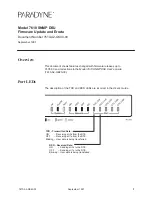
User Manual
Publication date: March, 2006
Revision A2
90
3-9. STP Configuration
The Spanning Tree Protocol (STP) is a standardized method (IEEE 802.1D)
for avoiding loops in switched networks. When STP is enabled, ensure that only
one path is active between any two nodes on the network at a time. User can
enable Spanning Tree Protocol on switch’s web management and then set up other
advanced items. We recommend that you enable STP on all switches to ensure a
single active path on the network.
3-9-1. STP Status
Function name:
STP Status
Function description:
In the Spanning Tree Status, user can read 12 parameters to know STP
current status. The 12 parameters’ description is listed in the following table.
Parameter description:
STP State:
Show the current STP Enabled / Disabled status. Default is “Disabled”.
Bridge ID:
Show switch’s bridge ID which stands for the MAC address of this switch.
Bridge Priority:
Show this switch’s current bridge priority setting. Default is 32768.
Designated Root:
Show root bridge ID of this network segment. If this switch is a root
bridge, the “Designated Root” will show this switch’s bridge ID.
Designated Priority:
Show the current root bridge priority.
Root Port:
Show port number connected to root bridge with the lowest path cost.
Root Path Cost:
Show the path cost between the root port and the designated port of the
root bridge.
Current Max. Age:
Show the current root bridge maximum age time. Maximum age time is
used to monitor if STP topology needs to change. When a bridge does
not receive a hello message from root bridge until the maximum age time
is counted down to 0, the bridge will treat the root bridge malfunctioned
and issue a Topology Change Notification (TCN) BPDU to all other
bridges.
Summary of Contents for 3-Slot 24 Fast Ethernet + 2 Gigabit L2 Managed Switch with Redundant Power
Page 6: ...vi ...
Page 8: ......
Page 157: ...User Manual Publication date March 2006 Revision A2 149 Fig 4 1 Fig 4 2 ...
Page 254: ......
Page 255: ......
















































